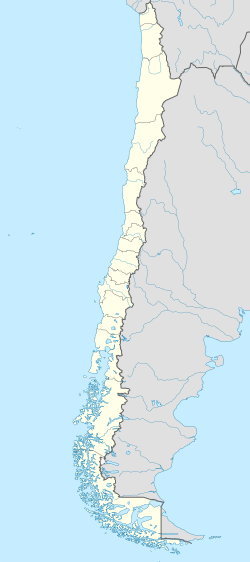Andacollo
This article needs additional citations for verification. (August 2008) |
Andacollo | |
|---|---|
 Andacollo Plaza | |
| Coordinates: 30°13′49″S 71°5′9″W / 30.23028°S 71.08583°W | |
| Country | |
| Region | |
| Province | Elqui |
| Government | |
| • Type | Municipality |
| Area | |
• Total | 310.3 km2 (119.8 sq mi) |
| Elevation | 1,019 m (3,343 ft) |
| Population (2012 Census)[2] | |
• Total | 11,093 |
| • Density | 36/km2 (93/sq mi) |
| • Urban | 9,444 |
| • Rural | 844 |
| Sex | |
| • Men | 5,148 |
| • Women | 5,140 |
| Time zone | UTC−4 (CLT) |
| • Summer (DST) | UTC−3 (CLST) |
| Area code | country 56 + city 51 |
| Website | Municipality of Andacollo |
Andacollo (Spanish pronunciation: [an.da.ˈko.ʝo]) is a city and commune in the Elqui Province, Coquimbo Region, Chile.
It is the central town of a mining district dominated by medium-scale mining.[3] There are gold placers and gold mineralizations within felsic volcanic rock in its vacinities.[4] The copper mine Carmen de Andacollo lies next to the town and most of workers live in the town.[5]
History
[edit]Andacollo is a copper and gold mining city located in the semi-arid mountains of the Norte Chico. It was founded in 1891.
The town was subject to gold rush in the early 1930s when there was a large inflow of gold miners exploiting local placer deposits.[4] While gold mining declined in the late 1930s, around 1935 Andacollo produced as much as 43% of all placer gold of Chile causing a shortage of water needed for processing.[4]
Several legends are told about the name of the city. Some say that it comes from the Quechua Anta-Goya which means cobre-reina (copper queen). Others say that the name means "Hurry up, Collo" (Anda, Collo). According to these legends, La Virgen del Rosario, also known as la Virgen Morena, or Black Madonna, appeared to an indigenous miner called "Collo" in the form of a small wooden statuette hidden in rocks. The statue told the newly converted Collo to build up a church at the place where Andacollo is located today. As many miracles are attributed to the Dark Lady (like stopping the smallpox epidemic of 1871) the city celebrates the Virgin every year on December 24 to 26.
Demographics
[edit]According to the 2002 census of the National Statistics Institute, Andacollo had 10,288 inhabitants (5,148 men and 5,140 women). Of these, 9,444 (91.8%) lived in urban areas and 844 (8.2%) in rural areas. The population fell by 16% (1,958 persons) between the 1992 and 2002 censuses.[2]
Administration
[edit]As a commune, Andacollo is a third-level administrative division of Chile administered by a municipal council, headed by an alcalde who is directly elected every four years.
Within the electoral divisions of Chile, Andacollo is represented in the Chamber of Deputies by Mr. Mario Bertolino (RN) and Marcelo Díaz (PS) as part of the 7th electoral district, (together with La Serena, La Higuera, Vicuña and Paiguano). The commune is represented in the Senate by Evelyn Matthei Fornet (UDI) and Jorge Pizarro Soto (PDC) as part of the 4th senatorial constituency (Coquimbo Region).
Gallery
[edit]-
Basilica of Andacollo
-
City view
-
City view
-
Aerial view of the city
-
Industrial gold mine
-
Traditional gold processing
-
Mercury evaporation to produce gold
References
[edit]- ^ "Municipality of Andacollo" (in Spanish). Archived from the original on 21 September 2010. Retrieved 6 September 2010.
- ^ a b c d "National Statistics Institute" (in Spanish). Retrieved 8 September 2010.
- ^ Distritos productivos para el desarrollo de la minería chilena [Productive districts for the development of mining in Chile] (Report) (in Spanish). Centro de Estudios y Documentación Mineros de SONAMI. 2025.
- ^ a b c Millán, Augusto (2006). La minería metálica en Chile en el siglo XX [Metal Mining in Chile in the Twentieth Century] (in Spanish). Santiago de Chile: Editorial Universitaria. pp. 13–14. ISBN 956-11-1849-1.
- ^ "About Carmen de Andacollo". Teck.com. Retrieved 2025-05-08.
External links
[edit]- (in Spanish) Municipality of Andacollo










